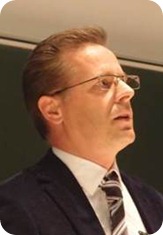
How has DNA synthesis previously been carried out in the lab?
Automated DNA synthesis has been around for almost three decades. The key difference between the established methodology for making oligodeoxynucleotides (short stretches of single-stranded DNA) and our method is the template strand.
During conventional DNA synthesis, the sequence is determined by the flow of solutions from bottles containing the four different building blocks (A, C, G, or T), controlled by a computer. In our case, the synthesis is directed by a template strand and is entirely (bio)chemical.
So, our method is closer to what nature does when DNA is replicated prior to cell division. We use a more reactive group on the building blocks (an amino group), and we keep this group in an unreactive state during the incorporation into the growing strand, using what synthetic chemists call a 'protecting group' to prevent unspecific polymerization. So, the selection of the correct base at each step can be governed by Watson-Crick base pairing.
How crucial were enzymes to this technique?
Not at all. Our method is enzyme-free. This is what makes it exciting.
Have you managed to produce a copying technique without enzymes?
Yes, we believe so. I should mention, though, that we are currently reading out fairly short stretches of the template sequence, and the error rate is rather significant.
This new technique can synthesize DNA in both the direction preferred by nature (3’ direction) and the opposite direction (5’ direction). What are the benefits of this?
At this point, we consider this work basic research. So, it is interesting to see that template-directed synthesis of a daughter strand is not limited to growth in the 3' to 5' direction. If nature were to run replication in both directions, there would be no need for Okazaki fragments. We hypothesize that nature did not choose this option to better control replication processes.
What are the current limitations to this method?
What we are producing is technically not DNA, but a close analog of DNA with one oxygen atom being replaced by an NH moiety. The two structures are isoelectronic (same number of electrons) and roughly isosteric (similar three-dimensional stuctures in the duplex), but they are not identical.
This can have benefits, but it is also a limitation. We are working on versions that use unmodified RNA building blocks to overcome this limitation. Also, as mentioned earlier, we are currently limited to short stretches (one helical turn, 10 nucleotides), mostly because of our analytical technique (mass spectrometry).
How do you think DNA synthesis methods will develop in the future?
There is a race for methods that produce longer strands in a single run on a DNA synthesizer, so that fewer ligation reactions are needed to assembly synthetic genomes. We are not part of that race. Our work focuses on demonstrating the intrinsic ability of nucleic acids to replicate.
Do you have any plans for further research into this area?
Oh, yes. The next 'summit' we are hoping to climb is to demonstrate several rounds of copying without enzymes. We are also very interested in what sequences survive several rounds of replication.
Where can readers find more information?
http://chip.chemie.uni-stuttgart.de/
About Clemens Richert

Ph.D. in Human-Biology, 1993, L.M.U. Munich, Ph.D. in Chemistry, 1994, ETH Zurich
Currently chair of Biological Chemistry at the University of Stuttgart
President of the German Nucleic Acid Chemistry Society (DNG, see: http://dnarna.de).